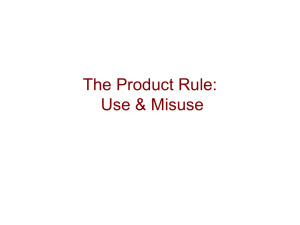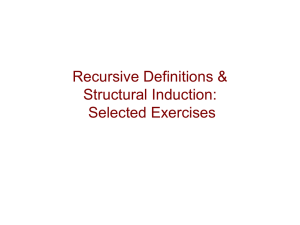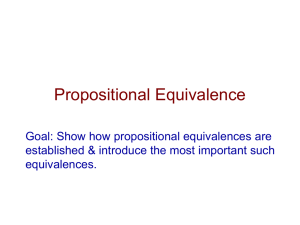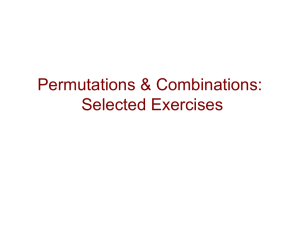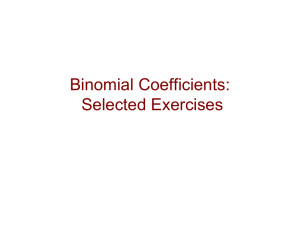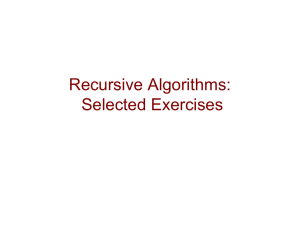Document
advertisement
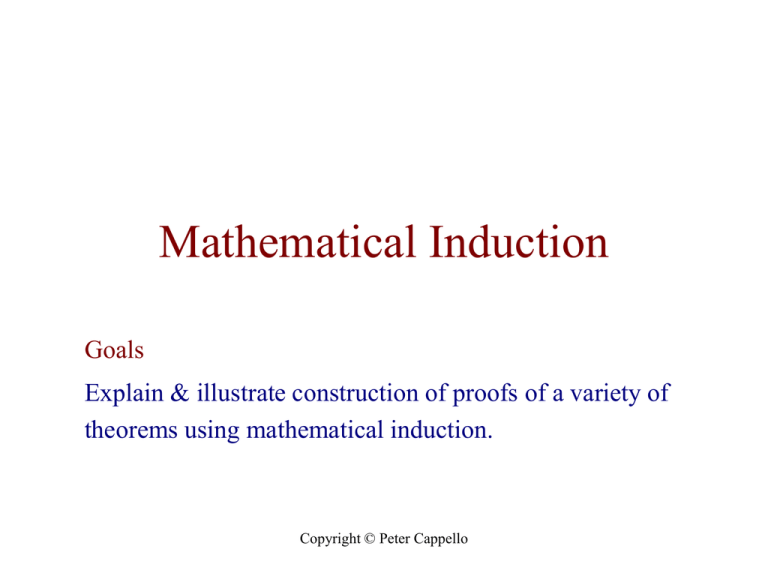
Mathematical Induction
Goals
Explain & illustrate construction of proofs of a variety of
theorems using mathematical induction.
Copyright © Peter Cappello
Motivation
• Mathematics uses 2 kinds of arguments:
• deductive
• inductive
• Proposition: P( n ): 1 + 2 + … + n = n( n + 1 )/2.
• Observe that P(1), P(2), P(3), & P(4). Conjecture: nN P( n ).
• Mathematical induction is a finite proof pattern for proving
propositions of the form nN P( n ).
Copyright © Peter Cappello
The Principle of Mathematical
Induction
•
Let P( n ) be a predicate function: nN P( n ) is a
proposition.
•
To prove nN P( n ), it suffices to prove:
1. P( 1 ) is true.
2. nN ( P( n ) P( n + 1 ) ).
•
This is not magic.
•
It is a recipe for constructing a finite proof for arbitrary nN.
Copyright © Peter Cappello
Proving P( 3 )
• Given P( 1 ) n 1 ( P( n ) P( n + 1) ).
• Proof:
1. P( 1 ).
[premise 1]
2. P( 1 ) P( 2 ).
[U.S. of premise 2 for n = 1]
3. P( 2 ).
[step 1, 2, & modus ponens]
4. P( 2 ) P( 3 ).
[U.S. of premise 2 for n = 2]
5. P( 3 ).
[step 2, 3, & modus ponens]
• Construct a finite proof for P( 1,999,765 ).
Copyright © Peter Cappello
Mathematical Induction as the
Domino Principle
If
the 1st domino falls over
and
the nth domino falls over implies that the ( n + 1 )st domino
falls over
then
domino n falls over for all n N.
Copyright © Peter Cappello
Mathematical Induction as the
Domino Principle
1
2
3
n
n +1
Copyright © Peter Cappello
The 3-Step Method
•
The implication in step 2 typically is proved directly.
•
The proof pattern thus has 3 steps:
1.
Prove P( 1 ).
[called the basis]
2.
Assume P( n )
[called the induction hypothesis]
3.
Prove P( n + 1 )
[called the inductive step]
•
The last 2 steps are for arbitrary n N.
•
Using P( n ) to prove P( n + 1 ) implies a recursive formulation of P( n ).
Copyright © Peter Cappello
Induction as a Creative Process
• Mathematical induction is similar to, but not identical to,
scientific induction.
• In both cases, a “theory” is created.
• Look at specific cases; perceive a pattern.
• Hypothesizing a pattern, a theory, is a creative process
(only people who are bad at mathematics say otherwise).
• With mathematical induction, a “theory” can be proved.
Copyright © Peter Cappello
• Scientific theories cannot be proved.
• They can be disproved.
• A scientific theory can be based on a mathematical model.
• Propositions can be proved within the model.
• Like axioms, the relationship between:
• the mathematical model
• physical reality
cannot be proven correct.
Copyright © Peter Cappello
Example
• 1=1
• 3=1+2
• 6=1+2+3
• 10 = 1 + 2 + 3 + 4
• What is a general formula, if any, for 1 + 2 + … + n?
• Let F( n ): 1 + 2 + . . . + n.
• A recursive formulation: F( n ) = F( n - 1 ) + n.
Copyright © Peter Cappello
A Geometric Interpretation
• 1:
• 2:
• 3:
• Put these blocks, which represent numbers, together to
form sums:
• 1+2=
• 1+2+3=
Copyright © Peter Cappello
n
n
Area is n2/2 + n/2 = n(n + 1)/2
Copyright © Peter Cappello
1 + 2 + … + n = n(n + 1)/2
A Mathematical Induction Proof
• F( 1 ) = 1( 1 + 1 )/2 = 1.
• Assume F( n ) = n( n + 1 )/2
• Show F( n + 1 ) = ( n + 1 )( n + 2 )/2.
F( n + 1 ) = 1 + 2 + . . . + n + ( n + 1 ) [Definition]
= F( n ) + n + 1
[Recursive formulation]
= n( n + 1 ) / 2 + n + 1
[Induction hyp.]
= n( n + 1 ) / 2 + ( n + 1 ) (2/2)
= ( n + 1 ) ( n + 2 ) / 2.
Copyright © Peter Cappello
• In finding a recursive formulation, we focused on the:
• similarities
• differences
for successive values of n.
• Sometimes, it is useful to:
• Note the difference between F( n ) & F( n – 1 ).
• Find a pattern in this sequence of differences.
Copyright © Peter Cappello
Example:
3
1
+
3
2
+...+
• Let F( n ) = 13 + 23 + . . . + n3.
• What is a formula for F(n)?
•
1
= 13
•
9
= 13 + 23
•
36 = 13 + 23 + 33
•
100 = 13 + 23 + 33 + 43
• Do you see a pattern?
Copyright © Peter Cappello
3
n
=?
Prove that n F( n ) = [ n( n + 1 )/2 ]2
1. F( 1 ) = 13 = 1 = [ 1( 2 ) / 2 ]2.
2. Assume F( n ) = [ n( n + 1 ) / 2 ]2 .
I.H.
3. Prove F( n + 1 ) = [ ( n + 1 )( n + 2 ) / 2 ]2.
F ( n + 1 ) = 13 + 23 + . . . + n3 + ( n +1 )3
Defn. of F( n + 1 )
= F( n ) + ( n + 1 )3
Recursive formulation
= [ n( n + 1 )/ 2 ]2 + ( n + 1 )3
Use I. H.
= ( n + 1 )2[ ( n / 2 )2 + ( n + 1 ) ]
= ( n + 1 )2[ n2 / 4 + ( 4 / 4 )( n + 1 ) ]
= ( n +1 )2[ ( n2 + 4n + 4 ) / 4 ] = [ ( n + 1) (n + 2) / 2 ]2.
Copyright © Peter Cappello
Translating the starting point
•
If we:
• know P( n ) is false for 1 n 9
• think P( n ) is true for n > 9.
•
Then define Q( n ) = P( n + 9 ).
• Use mathematical induction to show that n N Q( n ).
• We thus can start the induction at any natural number.
Copyright © Peter Cappello
Example: Stamps
• Suppose the US Post Office prints only 5 & 9 cent stamps.
• Prove n > 34, you can make postage for n cents, using
only 5 & 9 cent stamps.
Let S( n ) denote the statement: You can make postage for
n cents using only 5-cent & 9-cent stamps.
1. Basis: For n = 35: Use 7 5-cent stamps.
2. I.H.: Assume S( n ).
Copyright © Peter Cappello
3. Prove S( n + 1 ).
Case: For S( n ), # of 9-cent stamps used = 0:
Only 5-cent stamps are used for S( n ).
# of 5-cent stamps ≥ 7.
Replace 7 5-cent stamps with 4 9-cent stamps.
Case: For S( n ), # of 9-cent stamp used > 0:
Replace 1 9-cent stamp with 2 5-cent stamps.
Copyright © Peter Cappello
Generalizing the Basis
• To prove nN P( n ), if suffices to show:
• P( 1 ) P( 2 ).
• nN( [ P( n ) P( n + 1 ) ] P( n + 2 ) )
• If:
• We can push over the first 2 dominos;
• Pushing over any 2 adjacent dominos implies pushing
over the next domino.
then we can push over all the dominos.
Copyright © Peter Cappello
The Fibonacci Formula
• Define the nth Fibonacci number, F( n ), as:
• F( 0 ) = 0, F( 1 ) = 1,
• F( n ) = F( n – 1 ) + F( n – 2 ).
• Prove
F( n ) = 5-1/2 ( [ ( 1 + 51/2 ) / 2]n - [ ( 1 - 51/2 ) / 2 ]n ).
Basis: F( 0 ) = 5-1/2 ( [ ( 1 + 51/2 ) /2 ]0 - [ (1 - 51/2) / 2 ]0 )
= 0.
F( 1 ) = 5-1/2 ( [ ( 1 + 51/2 ) / 2 ]1 - [ ( 1 - 51/2 ) / 2 ]1 )
= ( 5-1/2 / 2 ) ( 1 + 51/2 - 1 + 51/2 )
= 1.
Copyright © Peter Cappello
The Fibonacci Formula
F( n ) = 5-1/2 ( [ ( 1 + 51/2 ) / 2]n - [ ( 1 - 51/2 ) / 2 ]n )
• Let a = ( 1 + 51/2 ) / 2
b = ( 1 - 51/2 ) / 2.
•
Note: a + 1 = a2 & b + 1 = b2.
• Induction hypotheses:
F( n )
= 5-1/2 ( an – bn )
F( n +1 ) = 5-1/2 ( an + 1 – bn + 1 ).
• Induction step: Show F( n + 2 ) = 5-1/2 ( an + 2 - bn + 2 ).
Copyright © Peter Cappello
F( n ) = 5-1/2 ( [ ( 1 + 51/2 ) / 2]n - [ ( 1 - 51/2 ) / 2 ]n )
Proof of Induction Step
F( n + 2 ) = F ( n + 1 ) + F ( n )
[Definition]
= 5-1/2 ( an + 1 – bn + 1 ) + 5-1/2 ( an – bn )
= 5-1/2 ( an + 1 + an – bn + 1 – bn )
= 5-1/2 ( an ( a + 1 ) – bn ( b + 1 ) ).
= 5-1/2 ( an + 2 – bn + 2 )
Copyright © Peter Cappello
[I.H.]
Generalizing this ...
• If
• P( 1 ) P( 2 ) . . . P( k )
• n { [ P( n + 1 ) P( n + 2 ) . . . P( n + k ) ] P( n + k + 1 ) }
• then n N P( n ).
Copyright © Peter Cappello
End
Copyright © Peter Cappello
Strong Mathematical Induction
• If
• P( 1 ) P( 2 ) . . . P( k ) and
• for n k,
[ P( 1 ) P( 2 ) . . . P( n ) ] P( n + 1 )
• then, n N P(n).
Copyright © Peter Cappello
Example: Fundamental Theorem
of Arithmetic
• Prove that all natural numbers 2 can be
represented as a product of primes.
• Basis: 2: 2 is a prime.
• Assume that 1, 2, . . . , n can be represented
as a product of primes.
Copyright © Peter Cappello
• Show that n + 1can be represented as a
product of primes.
• Case n + 1 is a prime: It can be represented as a
product of 1 prime, itself.
• Case n + 1 is composite: n = ab, for some a,b < n.
• Therefore, a = p1p2 . . . pk & b = q1q2 . . . ql, where the
pis & qis are primes.
• Represent n = p1p2 . . . pkq1q2 . . . ql.
Copyright © Peter Cappello
